Citroen JUMPER 2008.5 2.G Owner's Manual
Manufacturer: CITROEN, Model Year: 2008.5, Model line: JUMPER, Model: Citroen JUMPER 2008.5 2.GPages: 163, PDF Size: 2.57 MB
Page 111 of 163
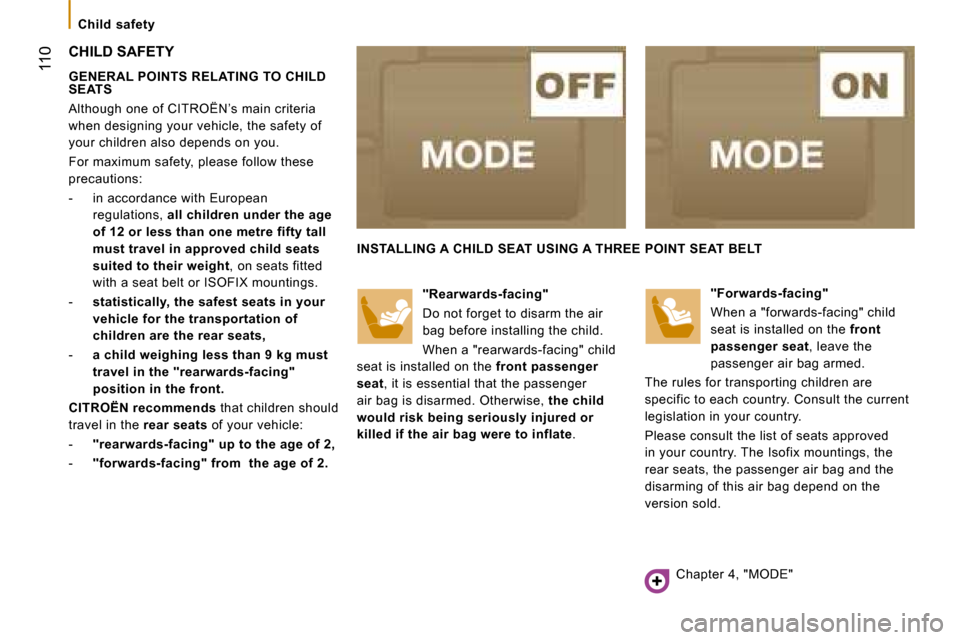
110
Child safety
CHILD SAFETY
GENERAL POINTS RELATING TO CHILD
SEATS
Although one of CITROËN’s main criteria
when designing your vehicle, the safety of
your children also depends on you.
For maximum safety, please follow these
precautions:
- in accordance with European regulations, all children under the age
of 12 or less than one metre fifty tall
must travel in approved child seats
suited to their weight , on seats fitted
with a seat belt or ISOFIX mountings.
- statistically, the safest seats in your
vehicle for the transportation of
children are the rear seats,
- a child weighing less than 9 kg must
travel in the "rearwards-facing"
position in the front.
CITROËN
recommends that children should
travel in the rear seats of your vehicle:
- "rearwards-facing" up to the age of 2
,
- "forwards-facing" from the age of 2.
Chapter 4, "MODE"
INSTALLING A CHILD SEAT USING A THREE POINT SEAT
BELT
"Rearwards-facing"
Do not forget to disarm the air
bag before installing the child.
When a "rearwards-facing" child
seat is installed on the front passenger
seat , it is essential that the passenger
air bag is disarmed. Otherwise, the child
would risk being seriously injured or
killed if the air bag were to inflate . "Forwards-facing"
When a "forwards-facing" child
seat is installed on the
front
passenger seat , leave the
passenger air bag armed.
The rules for transporting children are
specific to each country. Consult the current
legislation in your country.
Please consult the list of seats approved
in your country. The Isofix mountings, the
rear seats, the passenger air bag and the
disarming of this air bag depend on the
version sold.
Page 112 of 163
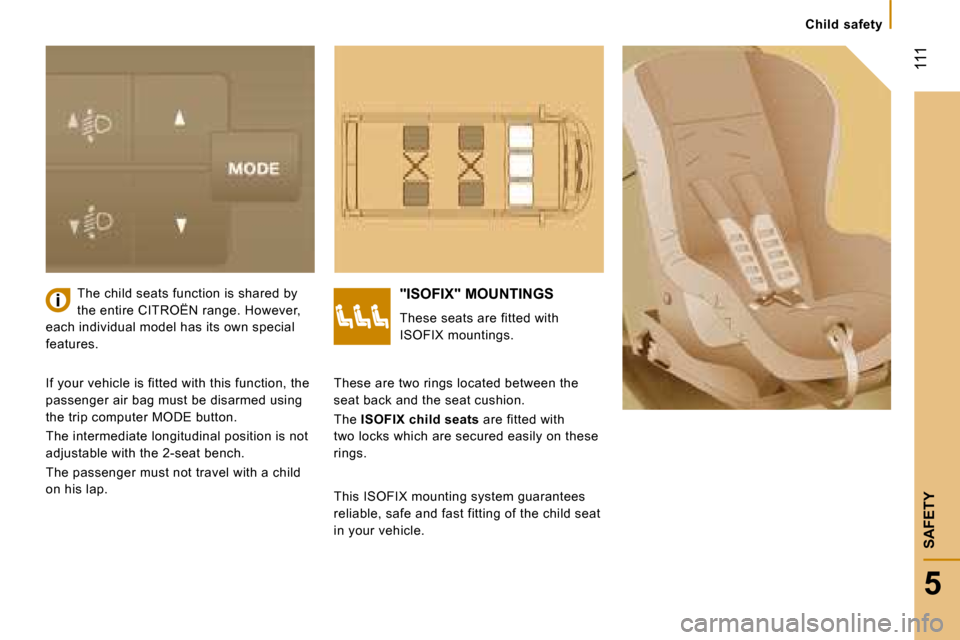
111
5
SAFETY
Child safety
The child seats function is shared by
the entire CITROËN range. However,
each individual model has its own special
features. "ISOFIX" MOUNTINGS
These seats are fitted with
ISOFIX mountings.
If your vehicle is fitted with this function, the
passenger air bag must be disarmed using
the trip computer MODE button.
The intermediate longitudinal position is not
adjustable with the 2-seat bench.
The passenger must not travel with a child
on his lap. This ISOFIX mounting system guarantees
reliable, safe and fast fitting of the child seat
in your vehicle.
These are two rings located between the
seat back and the seat cushion .
The ISOFIX child seats are fitted with
two locks which are secured easily on these
rings.
Page 113 of 163
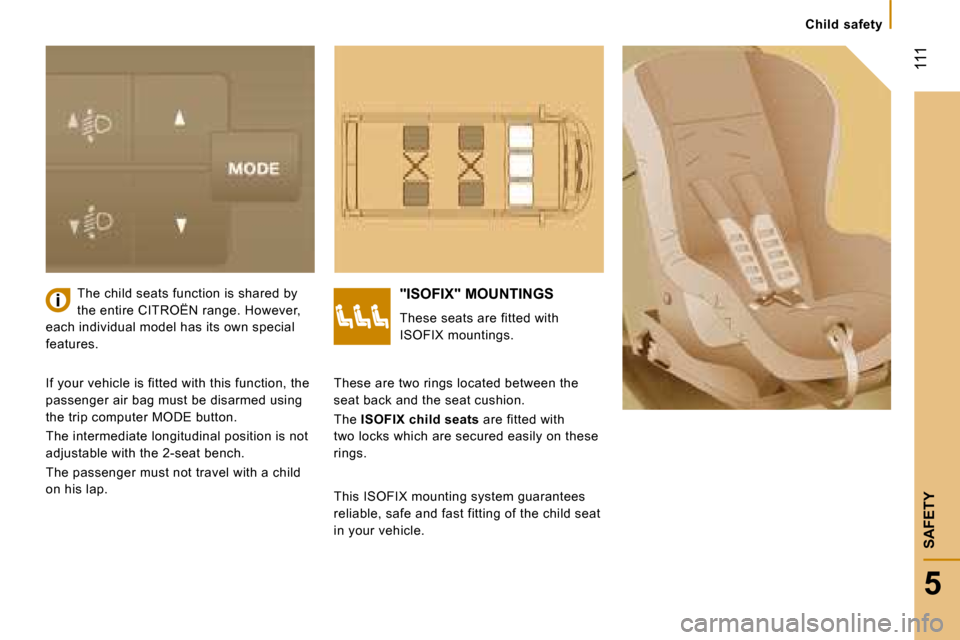
111
5
SAFETY
Child safety
The child seats function is shared by
the entire CITROËN range. However,
each individual model has its own special
features. "ISOFIX" MOUNTINGS
These seats are fitted with
ISOFIX mountings.
If your vehicle is fitted with this function, the
passenger air bag must be disarmed using
the trip computer MODE button.
The intermediate longitudinal position is not
adjustable with the 2-seat bench.
The passenger must not travel with a child
on his lap. This ISOFIX mounting system guarantees
reliable, safe and fast fitting of the child seat
in your vehicle.
These are two rings located between the
seat back and the seat cushion .
The ISOFIX child seats are fitted with
two locks which are secured easily on these
rings.
Page 114 of 163
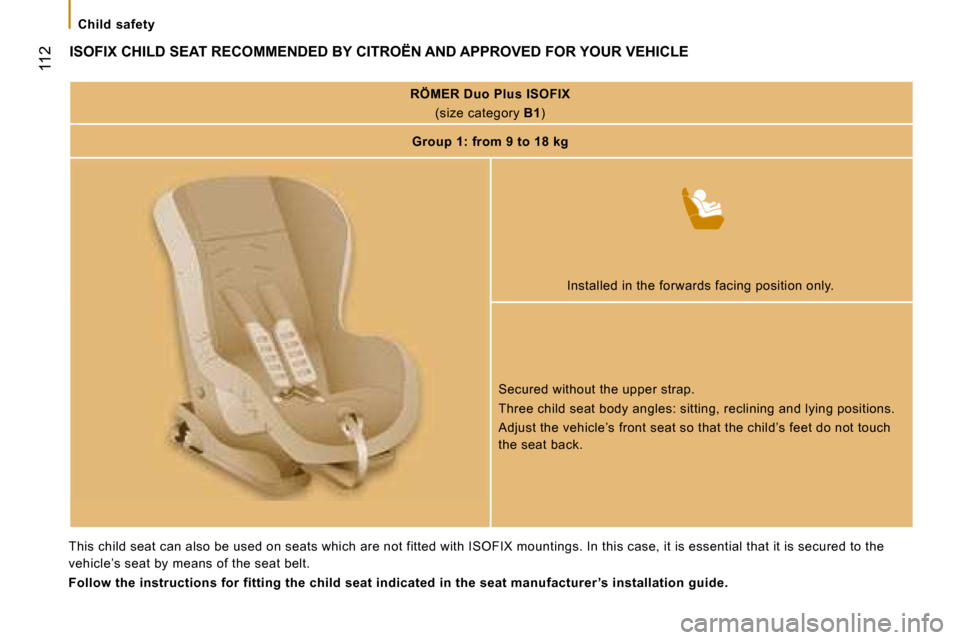
112
Child safety
ISOFIX CHILD SEAT RECOMMENDED BY CITROËN AND APPROVED FOR YOUR VEHICLE
RÖMER Duo Plus ISOFIX
(size category B1 )
Group 1: from 9 to 18 kg
Installed in the forwards facing position only.
Secured without the upper strap.
Three child seat body angles: sitting, reclining a nd lying positions.
Adjust the vehicle’s front seat so that the child’s feet do not touch
the seat back.
This child seat can also be used on seats which ar e not fitted with ISOFIX mountings. In this case, it is essential that it is secured to the
vehicle’s seat by means of the seat belt.
Follow the instructions for fitting the child seat indicated in the seat manufacturer ’s installation g uide.
Page 115 of 163
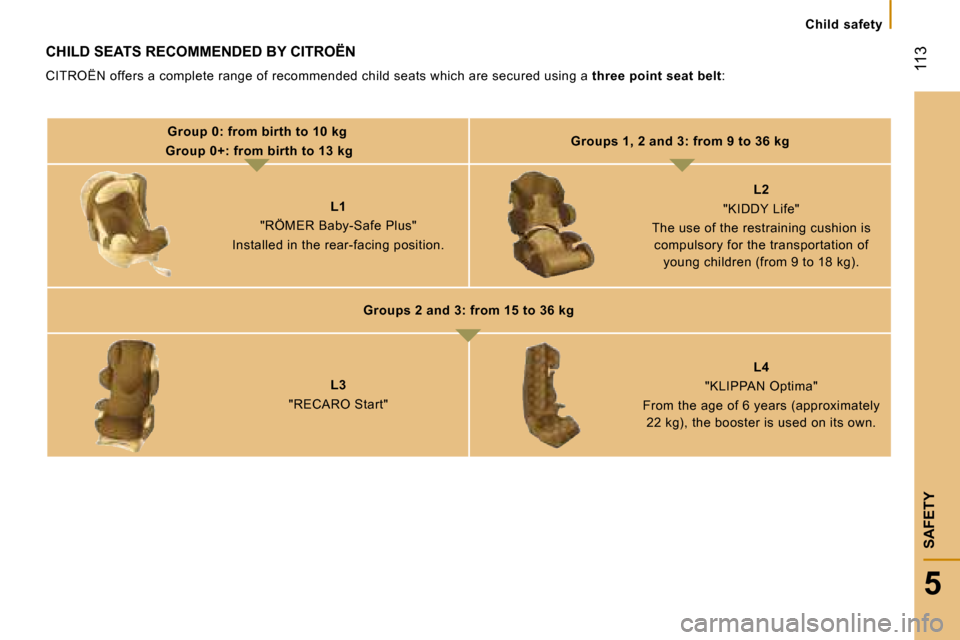
113
5
SAFETY
Child safety
CHILD SEATS RECOMMENDED BY CITROËN
CITROËN offers a complete range of recommended child seats which are secured using a three point seat belt :
Group 0: from birth to 10 kg
Group 0+: from birth to 13 kg
Groups 1, 2 and 3: from 9 to 36 kg
L1
"RÖMER Baby-Safe Plus"
Installed in the rear-facing position.
L2
"KIDDY Life"
The use of the restraining cushion is compulsory for the transportation of young children (from 9 to 18 kg).
Groups 2 and 3: from 15 to 36 kg
L3
"RECARO Start"
L4
"KLIPPAN Optima"
From the age of 6 years (approximately 22 kg), the booster is used on its own.
Page 116 of 163
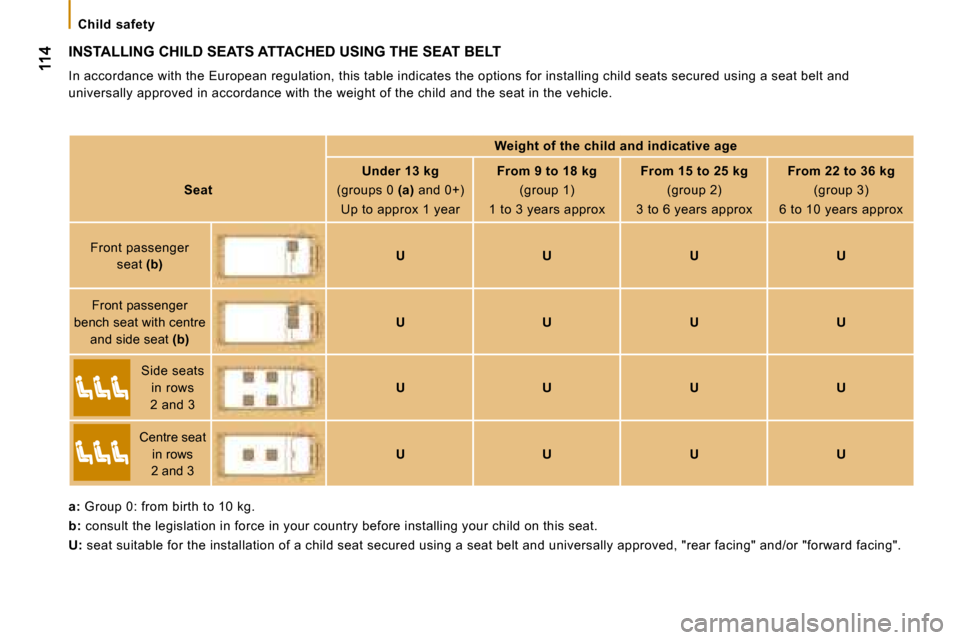
Child safety
INSTALLING CHILD SEATS ATTACHED USING THE SEAT BELT
In accordance with the European regulation, this table indicates the options for installing child seats secured using a seat belt and
universally approved in accordance with the weight of the child and the seat in the vehicle.
Weight of the child and indicative age
Seat
Under 13 kg
(groups 0
(a) and 0+)
Up to approx 1 year
From 9 to 18 kg
(group 1)
1 to 3 years approx
From 15 to 25 kg
(group 2)
3 to 6 years approx
From 22 to 36 kg
(group 3)
6 to 10 years approx
Front passenger seat
(b
)
U U U U
Front passenger
bench seat with centre and side seat
(b
)
U U
U U
Side seats in rows
2 and 3
U
U U U
Centre seat in rows
2 and 3 U U
U U
a
:
Group 0: from birth to 10 kg.
b
:
consult the legislation in force in your country b efore installing your child on this seat.
U
:
seat suitable for the installation of a child seat secured using a seat belt and universally approved , "rear facing" and/or "forward facing".
Page 117 of 163
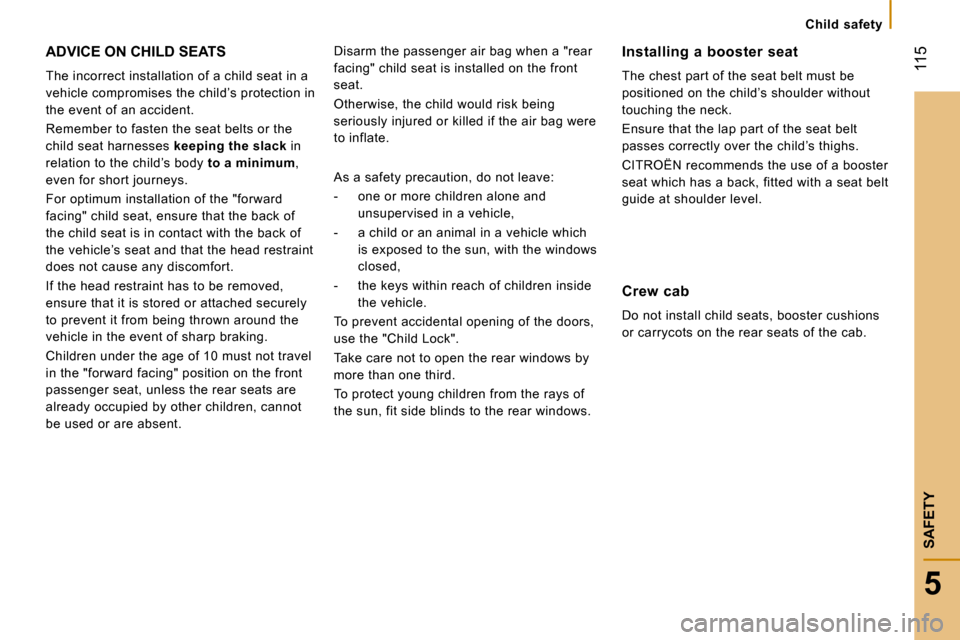
115
5
SAFETY
Child safety
ADVICE ON CHILD SEATS
The incorrect installation of a child seat in a
vehicle compromises the child’s protection in
the event of an accident.
Remember to fasten the seat belts or the
child seat harnesses keeping the slack in
relation to the child’s body to a minimum ,
even for short journeys.
For optimum installation of the "forward
facing" child seat, ensure that the back of
the child seat is in contact with the back of
the vehicle’s seat and that the head restraint
does not cause any discomfort.
If the head restraint has to be removed,
ensure that it is stored or attached securely
to prevent it from being thrown around the
vehicle in the event of sharp braking.
Children under the age of 10 must not travel
in the "forward facing" position on the front
passenger seat, unless the rear seats are
already occupied by other children, cannot
be used or are absent. Disarm the passenger air bag when a "rear
facing" child seat is installed on the front
seat.
Otherwise, the child would risk being
seriously injured or killed if the air bag were
to inflate.
As a safety precaution, do not leave:
- one or more children alone and
unsupervised in a vehicle,
- a child or an animal in a vehicle which is exposed to the sun, with the windows
closed,
- the keys within reach of children inside the vehicle.
To prevent accidental opening of the doors,
use the "Child Lock".
Take care not to open the rear windows by
more than one third.
To protect young children from the rays of
the sun, fit side blinds to the rear windows.
Installing a booster seat
The chest part of the seat belt must be
positioned on the child’s shoulder without
touching the neck.
Ensure that the lap part of the seat belt
passes correctly over the child’s thighs.
CITROËN recommends the use of a booster
seat which has a back, fitted with a seat belt
guide at shoulder level.
Crew cab
Do not install child seats, booster cushions
or carrycots on the rear seats of the cab.
Page 118 of 163
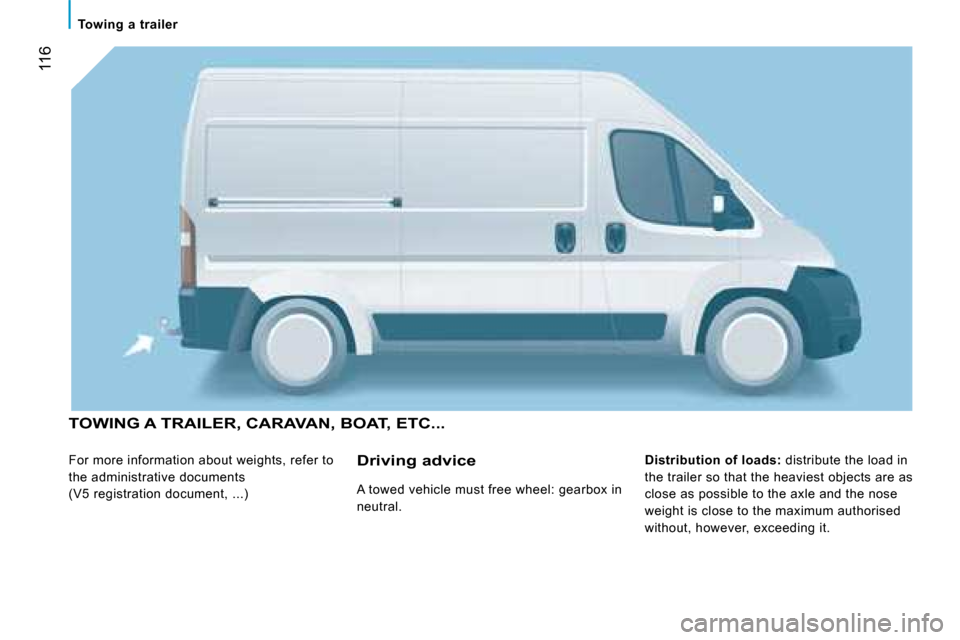
116
Towing a trailer
TOWING A TRAILER, CARAVAN, BOAT, ETC...
For more information about weights, refer to
the administrative documents
(V5 registration document, ...)
Distribution of loads: distribute the load in
the trailer so that the heaviest objects are as
close as possible to the axle and the nose
weight is close to the maximum authorised
without, however, exceeding it. Driving advice
A towed vehicle must free wheel: gearbox in
neutral.
Page 119 of 163
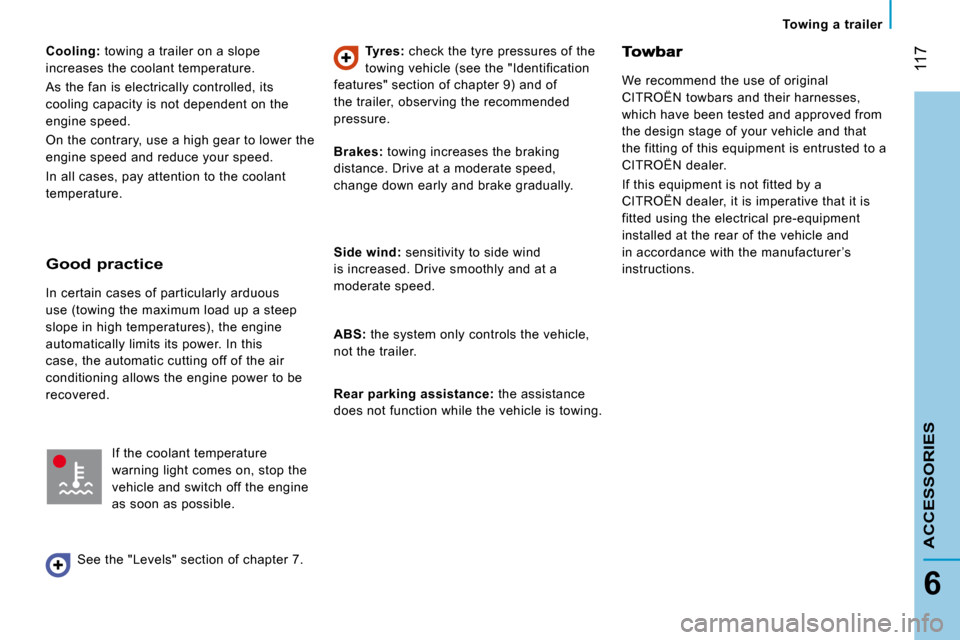
117
6
Towing a trailer
ACCESSORIES
Cooling: towing a trailer on a slope
increases the coolant temperature.
As the fan is electrically controlled, its
cooling capacity is not dependent on the
engine speed.
On the contrary, use a high gear to lower the
engine speed and reduce your speed.
In all cases, pay attention to the coolant
temperature.
Tyres: check the tyre pressures of the
towing vehicle (see the "Identification
features" section of chapter 9) and of
the trailer, observing the recommended
pressure.
We recommend the use of original
CITROËN towbars and their harnesses,
which have been tested and approved from
the design stage of your vehicle and that
the fitting of this equipment is entrusted to a
CITROËN dealer.
If this equipment is not fitted by a
CITROËN dealer, it is imperative that it is
fitted using the electrical pre-equipment
installed at the rear of the vehicle and
in accordance with the manufacturer ’s
instructions.
Good practice
In certain cases of particularly arduous
use (towing the maximum load up a steep
slope in high temperatures), the engine
automatically limits its power. In this
case, the automatic cutting off of the air
conditioning allows the engine power to be
recovered.
If the coolant temperature
warning light comes on, stop the
vehicle and switch off the engine
as soon as possible.
See the "Levels" section of chapter 7.
Brakes: towing increases the braking
distance. Drive at a moderate speed,
change down early and brake gradually.
Side wind: sensitivity to side wind
is increased. Drive smoothly and at a
moderate speed.
ABS: the system only controls the vehicle,
not the trailer.
Rear parking assistance: the assistance
does not function while the vehicle is towing.
Page 120 of 163
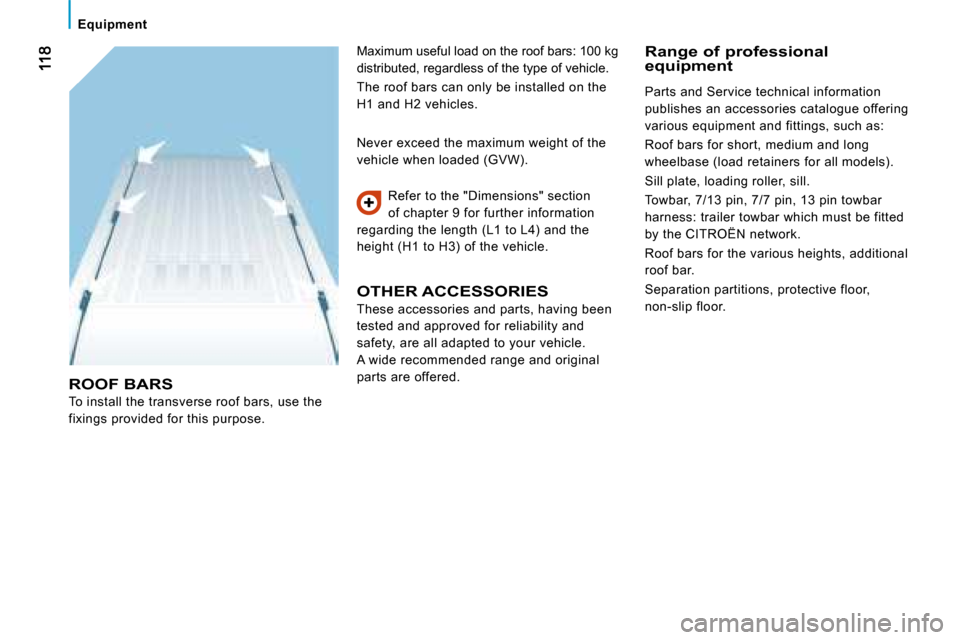
Equipment
ROOF BARS
To install the transverse roof bars, use the
fixings provided for this purpose. Refer to the "Dimensions" section
of chapter 9 for further information
regarding the length (L1 to L4) and the
height (H1 to H3) of the vehicle.
Never exceed the maximum weight of the
vehicle when loaded (GVW).
OTHER ACCESSORIES
These accessories and parts, having been
tested and approved for reliability and
safety, are all adapted to your vehicle.
A wide recommended range and original
parts are offered.
Range of professional equipment Maximum useful load on the roof bars: 100 kg
distributed, regardless of the type of vehicle.
The roof bars can only be installed on the
H1 and H2 vehicles.
Parts and Service technical information
publishes an accessories catalogue offering
various equipment and fittings, such as:
Roof bars for short, medium and long
wheelbase (load retainers for all models).
Sill plate, loading roller, sill.
Towbar, 7/13 pin, 7/7 pin, 13 pin towbar
harness: trailer towbar which must be fitted
by the CITROËN network.
Roof bars for the various heights, additional
roof bar.
Separation partitions, protective floor,
non-slip floor.